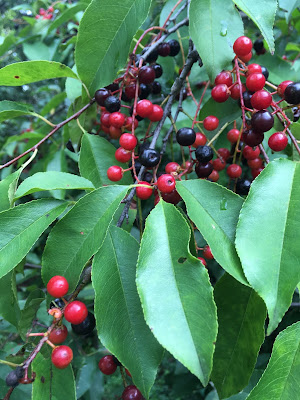 |
| Black cherry in spring-photo Krzysztof Ziarnek, Kenrais |
 |
| A red-spotted purple on black cherry |
As it turned out, I didn’t have to go out and buy or even dig up a black cherry seedling. One arrived right on schedule in the clearing created when we removed two big hemlocks along the fence line. Black cherry travels when birds eat the berries (technically, drupes) and excrete the seeds wherever they go. An animal’s digestive system scarifies the seeds, breaking through their hard outer coating and preparing them to germinate.
 |
| The fruits turn from red to black |
Black cherry seems to have adapted particularly well to living around humans. It used to grow mostly in forests and can reach a height of 100 feet, which makes it the tallest cherry tree. But now it takes advantage of growth opportunities in areas of new construction or open ground such as the space left by our late hemlocks. Black cherry grows in sun or part shade and puts up with moist or dry conditions.
 |
| Distinctive leaves |
To me, the tip-off is the shiny leaves, extended ovals ending in a pointed tip. In spring it covers itself with wands of tiny white flowers.
 |
| The little white cherry flowers attract pollinators-photo AnRo0002 |
I learned that black cherry has found a way to enlist ants to protect it from leaf-eating insects: extra-floral nectaries. As Ohio State University Extension blogger Joe Boggs writes, “Nectar is the currency used by plants to pay insects and other animals to do their bidding.” Most flowering plants locate this sugary liquid inside flowers, but many species add less conventional nectar outlets. Cherries ooze nectar from little knobs on the petioles, or leaf stems.
 |
| The dark bumps on this leaf stalk are extra-floral nectaries |
Ants swarm the foliage to harvest the nectar. While they’re at it, they eat leaf-eaters; for example, one visiting ant species preys on Eastern tent caterpillars.
Although black cherry’s nectar and fruits are delectable, its leaves are poisonous. They contain glycosides that hydrolyze to hydrogen cyanide in an animal's digestive system.
With tolerance for a range of growing conditions, irresistible fruit and nectar, and dual strategies for defending its leaves, this tree is a resourceful survivor. When it was introduced to Europe, it became invasive there. Here it fits into plant communities without taking over.
The black cherry that emerged last year in the new clearing is now three feet tall and bushy. The question for my garden will be how big I’ll let this tree get and how many of its relatives I’ll allow to grow here. With birds spreading the seeds, there will always be new saplings ready to fill any patch where sunlight reaches the ground.
 |
| A younger black cherry volunteering in the yard |
No comments:
Post a Comment